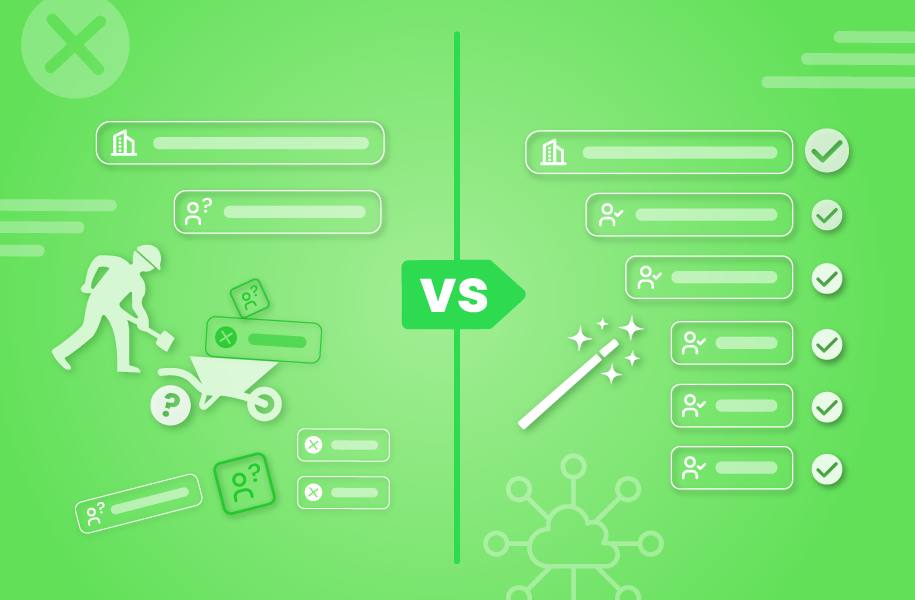Introduction
Whether you’re new to the world of revenue operations or just need to brush up on some terms, we’ve got you covered.
From lead routing, to account hierarchies, to deduplication, and everything in between, here’s our Complete guide to RevOps terms.
You might also like:
- What’s the difference: Salesforce duplicate rules vs. duplicate resolution
- What’s an account hierarchy?
- Beyond lead routing: Best use cases for routing any object in Salesforce
The Complete guide to RevOps terms
Revenue Operations
Account-based Marketing: Account-based marketing is a selling strategy that targets specific, high-value accounts instead of a larger audience. This approach can include creating personalized campaigns, content, and experiences that are tailored specifically to these target accounts.
Account Manager (AM): An account manager is responsible for growing and maintaining relationships with clients or customers on behalf of a company. Responsibilities of this role can include client relationship management, sales and growth, and strategic planning.
B2B: B2B, or business-to-business, describes a business model that involves transitions between two different businesses. This could include a manufacturer and a wholesaler, or a wholesaler and a retailer.
B2C: B2C, or business-to-consumer, refers to a business model in which good and services are sold directly to the end-user.
Business Development Rep (BDR): A business development rep, or BDR, is a role that generates new business by finding potential customers, creating outreach strategies, and identifying sales leads. Responsibilities of this role can include prospecting, outreach, and qualification.
Buyer Persona: A buyer persona is a representation of your ideal customer based on market research, as well as information and data about your existing customers. This helps businesses better understand the audience that they want to market and sell their products to.
Churn Rate: Churn rate is a business metric that calculates the number of customers who leave a product or service over a specific period, divided by the remaining number of customers. This metric can be used to understand customer retention and the longevity of customer relationships.
Conversion Rate: A conversion rate is the percentage of users who take a measurable action, such as making a purchase or signing up for a newsletter. This metric evaluates the effectiveness of marketing strategies, web pages, and sales efforts.
CRM: Customer Relationship Management is a technology for managing your company’s relationships and interactions with current and potential customers. It helps businesses stay connected to customers, streamline processes, and improve profitability.
Customer Success:
Go-To-Market Strategy: A go-to-market (GTM) strategy is an action plan that describes how a company will reach target customers. It often entails the different sales, marketing, and distribution strategies that a company will use.
Ideal Customer Profile: An ideal customer profile (ICP) is a fictional description of an organization that would receive the most value from your product or service. Creating these profiles helps companies identify and qualify the best leads to focus their marketing and sales efforts on.
Land and Expand: Land and expand is a selling tactic that often targets large, enterprise companies with smaller deals. By building trust over time, those small deals expand into long-term partnerships and eventually result in continued sales and revenue across the company.
Lead Scoring: Lead scoring is a system used to score prospects and rank them with a certain value. Lead scoring helps prioritize leads, respond to them appropriately, and increase the rate in which leads convert to customers.
Marketing Automation Platform: A marketing automation platform is software designed to automate marketing actions, such as emails, social media, or other tasks.
Marketing Qualified Lead (MQL): A marketing qualified lead (MQL) is a lead that has shown a certain amount of engagement and is more likely to become a customer compared to other leads. This lead will show engagement in various marketing activities, such as downloading an eBook, attending a webinar, or clicking on targeted ads.
Marketing-to-sales handoff:
Revenue Operations (RevOps): Revenue operations, or RevOps, is a business function aimed to maximize a company’s revenue by breaking down the silos between marketing, sales, and customer service.
Sales Development Rep (SDR): A sales development rep, or SDR, is a role responsible for moving leads through the sales pipeline. They often take over a lead once it has been identified and qualified, to nurture relationships with potential clients and hand them off to an Account Manager (AM) who will close the deal.
Sales Qualified Lead (SQL): A sales qualified lead (SQL) is a prospective customer that has been researched and vetted by both the marketing department and the sales team. These leads typically show intent to purchase a product or service and are deemed ready for the next step of the sales process.
Total Addressable Market (TAM): Total addressable market (TAM) refers to the total revenue opportunity that is available if 10o% market share is achieved. It helps businesses understand the potential scale of a market and can be used for forecasting and strategic planning.
Lead Routing
Accounts: In Salesforce, an account represents a company, organization, or other business entity in your CRM.
Account Routing: The automated process of routing matched leads to an account owner or alternate owner based on specific criteria.
Assignment Flow: An assignment flow is a sequence of steps used to assign records in Salesforce (such as leads or accounts) to users or queues based on specific rules.
Lead: A lead in Salesforce is a potential sales contact, person, or organization that expresses interest in your company’s products or services.
Lead Routing: Lead routing, or routing, is the process of distributing or assigning leads amongst sales reps or teams. Lead routing will often use different criteria such as geographic location, company size, or product interest.
Lead-to-lead assignment: The process of matching leads to other leads. Doing so can allow sales to get credit for outbound efforts, better understand expressions of interest, and allow different members of the sales team to own leads versus accounts.
Matching: Matching refers to identifying and linking related records, such as connecting a lead record with an existing account record based on similar attributes.
Match Flow: A match flow is a sequence of steps that defines how records are matched within Salesforce, typically using Match Rules.
Match Rules: Match rules are specific criteria used to identify and connect similar records that exist in Salesforce.
Opportunity Routing: Opportunity routing is the process of assigning sales opportunities to the appropriate sales reps or teams. This process ensures that potential deals are handled by the most appropriate or available person.
Partner Routing: Similar to lead or opportunity routing, partner routing manages records that are related to partners. Examples of these could be channel partners or resellers.
Record: A single piece of data that exists in Salesforce or another CRM. Leads, contacts, accounts, and opportunities are all different kinds of records.
Record Flow: A sequence of steps that can automatically create records and populate them with data from matched records, static values, or relative dates.
Round Robin: A round robin is a method of assigning records, such as leads or cases, to users in a rotational order. This can help ensure that leads and overall workload are distributed evenly.
Scheduled Flow: A flow in Salesforce that triggers and runs at specified times. This feature can be used to automate tasks such as data updates or record assignments.
Weighted Round Robin: A weighted round robin is an enhanced version of a round robin, where the assignment is based on weighted criteria. This method considers factors like the experience level or workload of a sales rep.
Account Hierarchies
Account Hierarchy: An account hierarchy is a representation of the parent-child relationships between various accounts in Salesforce, demonstrating how different accounts are related or connected.
Automated Chain Linking: The process of automatically connecting related accounts into an account hierarchy based on specific rules or criteria.
Bad Link: A bad link occurs when the connection between records is incorrect, which can lead to confusion or errors in data management.
Complete Company ID: The “Complete Company ID” field in Traction Complete contains a text string that uniquely identifies the account’s hierarchy. This allows all accounts in the same hierarchy to contain the same hierarchy identifier.
Data Enrichment: The process of enhancing existing data or records in a CRM with additional information from internal or external sources. This typically improves the accuracy and usefulness of the records.
Data Provider: A service or platform that provides data that can be used for enrichment or integration in Salesforce.
Manual Chain Linking: The process of manually connecting related accounts to build an account hierarchy in Salesforce.
Missing Account: A missing account is an instance where there’s a gap in the account hierarchy, leading to an incomplete hierarchy.
Missing Link: A missing link occurs when two records that should be connected are not, leading to an incomplete account hierarchy and potential data issues.
Rollups: Traction Complete’s rollup tool allows users to visualize desired data within a user’s Salesforce org.
Whitespace: Unique to Traction Complete, whitespace defines accounts in that belong to an account hierarchy but have not been added to the CRM.
Deduplication
Dirty Data: Data that is inaccurate, incomplete, or outdated, and can lead to inaccuracies, inefficiencies, or errors in business processes.
Duplicate: A record in Salesforce that is an unintended copy of another record, containing the same or similar information.
Mass Deduplication: The process of removing a large volume of duplicate records from Salesforce in one instance.
Proactive Deduplication The practice of preventing duplicate records from entering a CRM, typically through the use of validation rules or matching criteria.
Reactive Deduplication: The process of identifying and merging duplicate records from a CRM after they have already been created.
Influence and Relationship Mapping
Relationship Map: A Salesforce tool that allows sellers to visualize organization structures and identify stakeholders in open deals.
Learn more about Traction Complete
With more than a decade of expertise in the Salesforce ecosystem, Traction Complete creates a suite of Salesforce-based solutions that help revenue teams manage their data complexity, effortlessly.
Our apps automate data cleanup, account hierarchies, matching and routing, relationship and influence mapping, and mass territory reassignment.
To learn more about our powerful solutions and our best-in-class customer success team, book a demo today.





